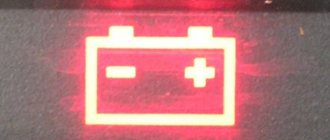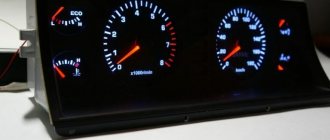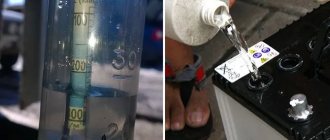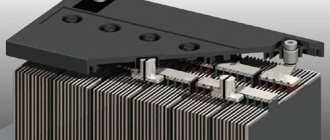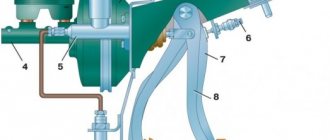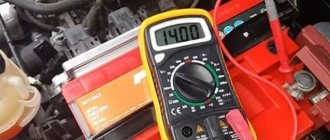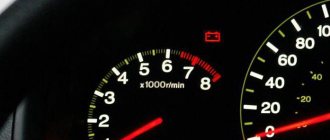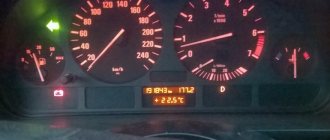As you know, the battery is an important element in the design of any car. At the same time, the battery constantly consumes energy to start the internal combustion engine, and also powers various electronic devices connected to the on-board network. Normally, the battery is charged from the generator after the engine is started, but for a number of reasons this process can be disrupted.
As a result, the battery is not fully or partially charged, which causes problems with starting the engine, deteriorates the condition of the battery, etc. Also, a problem with charging the battery often indicates certain breakdowns that require elimination and are in no way related to the battery itself. Next, we will look at why the battery is not charging, as well as how to check, find and fix the problem yourself.
How to find out if the battery is not charging
You can find out that the battery has stopped taking a charge from the on-board equipment of the car - this will be indicated by a lit battery light. When the engine is running, all electronics are powered from the generator, and the battery is recharged from it at this moment. But there are cases when the battery remains discharged when the generator is working. How, then, can you find out whether current is flowing to it or not?
Everything is simple here, you will need to measure the voltage at the battery terminals with a multimeter. If there is no charging, then the screen will show a value of 12 Volts or lower. With a normally functioning battery, the value should be at least 14 V. Measurements are taken with the engine running.
If, due to a dead battery, you cannot start the engine, then using the same multimeter you should measure the voltage at the battery terminals. A reading of 11.8 V will indicate a minimum charge. If 12.8 V, the battery is fully charged. The measurement is carried out with the ignition switched off.
Another way to check the battery is to charge it from a charger. If the process does not start, then the problem is in the battery.
There may be several reasons for battery failure, these are:
- the service life has expired - usually after 5 years of use;
- terminal oxidation;
- low electrolyte density - decreases due to evaporation, measurement is carried out with a hydrometer, normal values are 1.25-1.29 g/cm3;
- sulfation of plates - can occur with strong discharge, prolonged hypothermia, storage in a discharged state, or excess electrolyte density;
- short circuit between banks;
- destruction of one or more plates;
- contacts are reversed;
- the presence of impurities in the electrolyte.
If the battery takes charge well from the charger, then the reason for its rapid discharge in the car may be the following:
- the alternator belt has broken or stretched;
- the wires on the generator have oxidized;
- diodes have failed;
- brushes are worn out;
- malfunctions in the relay regulator.
The battery may not charge well even without obvious faults. This can happen with frequent engine starts and short distance driving, especially during cold periods of the year. The battery simply does not have time to recharge.
Control of other elements of the charging system
To determine why the alternator is overcharging or not charging the battery at all, you may need a multimeter. Using the tester, you can measure the battery voltage in two modes. With the engine turned off, the charge parameter should be in the range of 12.5-12.7 volts, and with the engine running - 13.5-14 volts. If these indicators are lower when the internal combustion engine is switched on, this may indicate problems in the operation of the diode bridge or brush assembly. By the way, brushes can wear out, so they need to be changed periodically.
If the cause of overcharging or lack of charging is a relay, it can be eliminated by replacing or resoldering the diodes. If the diodes will be soldered, it is necessary to select devices that are closest in technical characteristics. Otherwise they may overheat.
Battery testing and restoration
The battery is consumable and its service life is limited to approximately 5 years. And this is with timely maintenance and proper operation - without deep discharges, prolonged exposure to frost, etc.
How can you understand that the problem is not in the on-board system, but in the battery? This is quite easy to do using simple methods. And then all that remains is to eliminate the cause.
Low electrolyte density
The density of the electrolyte is checked with a special device - a hydrometer. Measurements are taken separately in each of the cans. In the new battery the indicators are around 1.26-1.27 g/cm3. During charging, its density gradually increases. If the level does not change, this indicates that the battery is not charging. Also, a problem in the composition of the electrolyte is indicated by the presence of suspensions or turbidity of the liquid.
Recovery takes place in the following sequence:
- The cloudy solution is carefully drained.
- The jars are washed with distilled water.
- Fresh solution is poured.
- The battery is being charged.
While washing, check the condition of the plates and contacts. When performing work, use personal protective equipment.
Short circuit of plates
The battery will not charge if the lead plates inside it are shorted. This can happen due to their partial or complete shedding and contact of the metal with conductive elements.
Also, the cause of a short circuit may be the failure of the separators. As a result, the positive and negative terminals touch. Such a defect can be caused by various types of deformations.
Signs of a short circuit:
- decrease in electrolyte density;
- rapid loss of charge;
- low voltage without load (10.4-10.8 V).
In rare cases, the banks can be restored, then the battery will last for some time. However, more often in case of a short circuit the battery must be replaced.
Sulfation of plates
Often the battery does not charge well due to the formation of deposits on live parts. It may occur due to the battery being in a discharged state for a long time, due to the evaporation of water and an increase in the density of the electrolyte. This is a phenomenon in which a white mass covers the electrodes. In the initial stage, the battery can be restored by performing cyclic charging.
The battery may not be fully charged if the integrity of the case is damaged, as this provokes evaporation and leakage of the electrolyte. Cracks are sealed using soldering or adhesives. Before restoration, drain the electrolyte, and then rinse and dry the jars.
Cleaning is carried out in the following sequence:
- The internal and external surfaces of the housing are washed with distilled water.
- The battery is thoroughly dried.
- The hull is being repaired.
- The required quantity and composition of electrolyte is poured.
- The battery is charged and during this process the density of the electrolyte is checked. If necessary, the composition of the solution is adjusted.
- The charger does not turn off until fully charged.
Sulfation is often confused with plate failure. It is very easy to distinguish it; to do this, just check the composition of the electrolyte. The presence of suspensions in it will indicate this problem.
Due to the simultaneous use of the gadget
Why is this happening:
Everyone is accustomed to the fact that a modern smartphone can be used while charging, but this is not always true. It all depends on the level of complexity of the tasks. Some applications consume a large amount of energy, and the battery does not have time to replenish its charge or even continues to lose it while connected to the power supply. For example, this can happen if you play complex 3D games that are demanding on performance while charging. The same applies to complex software for editing videos or working with music.
It is not advisable to use a smartphone while charging, especially loading it with heavy applications | Dignited
What to do:
In such cases, you should leave the smartphone alone and make sure that the applications are not minimized, but closed (this applies to a greater extent to Android). It is better to continue loading the mobile device to one hundred percent after its battery charge reaches the same hundred percent.
Problems with the generator
In modern cars, four elements are responsible for powering all on-board systems, including recharging the battery - a generator with a built-in rectifier, a relay regulator, a switch and wiring. The list is not particularly long, but difficulties often arise when diagnosing and identifying the causes of failure.
Possible malfunctions and what they lead to
The first step is to figure out why the generator does not charge the battery. There may be several reasons:
- Broken, worn or loose tension of the alternator belt. With such a defect, it either stops working altogether, or the generated current is only enough to power the on-board systems, and is not enough to charge the battery.
- Brush wear. The generator stops producing electricity and all systems are powered by the battery, so it discharges very quickly.
- Poor contact. Usually on the excitation circuits, but sometimes the cause is oxidation at the battery terminals or in the wiring.
- The diodes have failed. May occur due to improper lighting. If even a few diodes fail, the voltage drops and may not be enough to charge the battery normally. If the entire bridge breaks down, electricity generation stops completely.
- Malfunctions in the relay regulator. This could be a broken relay - the battery stops charging and powers the on-board systems of the car. Relay closure – too high voltage is generated, causing the battery to “boil” and on-board systems to burn.
- The fuse has blown. In some car models, the generator excitation coil is powered through a separate fuse. If it fails, the generator will stop charging the battery.
Below we will look at each case in more detail and find out how to get rid of this or that problem.
Belt problems
When the generator stops producing electric current, the first thing to look for is the problem in the belt, or rather in its integrity. Even an inexperienced car enthusiast can easily detect serious defects. But weak tension is more difficult to identify, because the generator sometimes works normally, sometimes it doesn’t.
To detect a problem, you can rely on the dashboard indicators - if there is a defect, they light up almost all the time. The damage can be eliminated by tightening the belt or replacing it with a new one.
Diodes, regulators, brushes are out of order
The generator stops charging the battery if the diodes are faulty. You can detect a breakdown using a multimeter or tester. Diodes can be replaced individually or as a whole bridge.
You can find out about a failed regulator by excessive overheating of the diode motor - when the battery is recharged, the semiconductors become very hot. When working with a broken regulator, constant voltage surges occur. The only way to fix the problem is to replace it.
Also, insufficient voltage to fully charge the battery may occur due to wear on the generator brushes. If you don't replace them, the generator will stop producing electricity altogether.
Polarity reversal
If the battery is completely discharged, you can perform a polarity reversal. If done correctly, it will charge. This is carried out only if a change in the poles is observed, otherwise it is strictly not recommended to do this.
You can determine the pole reversal using a multimeter. Also, during the check, you should pay attention to the capacity of each can that is part of the lead-acid battery.
It is prohibited to reverse polarity in the following cases:
- the electrolyte has become cloudy and the battery drains quickly;
- lead plates are destroyed;
- short circuit in one or more banks;
- low electrolyte density.
For charging, you can only use chargers that have protective systems.
Overload
The main reasons why the battery receives current, but does not charge, is generator overload. It can occur when it is overloaded with regular and non-standard electrical consumers - various installations and gadgets. In this case, the generator begins to work at the limit.
More often, this problem can arise among novice car owners who use all kinds of units and devices, acoustics and lighting devices for tuning. Sometimes batteries with a larger capacity than those indicated in the technical documentation for the car are installed, or the original one is upgraded. Therefore, the voltage produced by the generator is not enough to cover the cost of electricity.
The generator does not produce rated voltage
When determining the cause of poor battery charging or complete lack of charging from the generator, experts recommend completely disassembling it. In this way the following faults can be identified:
- damage to the pulley - detected during a thorough inspection; if a defect is detected, it must be replaced;
- wear of current collecting brushes - during active use of the car, they require periodic replacement; when choosing the right ones, follow the recommendations of the car manufacturer;
- wear of slip rings - a defect leads to loss of properties and reduces the rated voltage supplied by the generator;
- failure of the diode bridge - elements requiring replacement are pressed in or soldered out.
There can be many reasons for a battery not charging, and if the problem is current leakage, it should be fixed immediately. After all, such defects lead to short circuits, fires, etc. It is important to check not only the battery, but also the generator.
Other reasons for the battery not charging
There are other reasons why the battery stopped charging - this is severe wear on the rotor, which is why it began to get stuck in the stator. The frequency of rotor stops may vary. The problem can only be solved by replacing the entire unit.
An equally common cause is a breakdown in the circuit, after which the battery also stops receiving current. In this case, it will be difficult to independently determine such a breakdown, so you will have to seek help from specialists.
If the battery does not charge from the charger
The most common reason is that the battery is completely dead and cannot “swing” with a small current in normal charging mode. This most often occurs on batteries that have not been used for a long time. Here you can try to increase the charging current and “push” the battery with a more extreme charging method. In most cases, this works, and the battery gradually restores its properties.
If you try to charge a non-working charger, the battery will also not respond at all. Then you should check the device using a multimeter or tester, or simply connect the battery to a working charger. If in this case the battery does not charge, then the reason lies inside it. You should always treat your car battery with care and never leave it unattended while charging. Especially if you charge it with a high current.
Reason. The battery does not have enough time to fully charge
The reason is typical for situations where the car is used for short trips, not exceeding tens of kilometers per day. For example, we went to the store, and that’s it – to the garage.
- Firstly, while the car was standing for a long time, the battery was fairly discharged by leakage currents.
- Secondly, you wasted energy from the battery when you started the engine to drive out, and when you left the store (at a minimum).
In total, a certain number of ampere-hours were taken from the battery, which the generator simply did not have time to return during a very short trip.
Causes of starter battery failures
The service life of a car battery charged at 25% is significantly reduced if:
- the generator and voltage regulator are faulty;
- the starter is faulty, leading to an increase in current or the number of attempts to start the engine;
- power wiring terminals are oxidized;
- powerful consumers are used during long periods of idle time in traffic jams;
- frequently start the engine and drive short distances, especially during cold periods of the year.
A low electrolyte level when using a battery is also one of the key reasons for its rapid failure. Therefore, in summer it is recommended to check its level more often, since due to high temperatures it evaporates faster. Also, with intensive use of the car (more than 60,000 km per year), it is necessary to check the electrolyte level every 3,000 - 4,000 km.
Primary diagnosis
The built-in indicator will help you identify the weak charge of one of the main electrical appliances. Manufacturers set the green color in the eye to determine the quality level, and the remaining colors will be signals to the owner about a weak charge or its absence. The worst sign of a bad battery is silence when you turn the key in the ignition.
It is worth paying attention to alarm signals in the form of temporary failures in starting the engine. You need to test the battery charge using a multimeter. To do this, several tests are carried out:
- general voltage level without load;
- total voltage under load;
- charge level for each “bank” under load and without it.
The difference in individual capacitances should not exceed the range of 1.7-1.8 V.
Battery charge level monitoring
The electrolyte density in the batteries being serviced is tested. The accuracy of the measurements is ensured by the fact that samples are taken for all containers. Deviations from the norm during cold periods of more than 25% must be eliminated. For warm seasons, a deviation of 40% or more is critical.
Some tips for extending battery life
You can keep the battery in working condition without letting it stop charging if you strictly follow the operating rules. Be sure to recharge it on time and keep the device clean. After purchasing a new battery, owners have many questions regarding the charging time and conditions of its use. Sometimes car enthusiasts do not know how to prepare a power source for installation on a car and whether it is worth doing it at all.
Any battery requires careful care and timely maintenance. This will help extend its operational life by at least a couple of years, as well as reduce interruptions in the operation of on-board electronics.
Here are 8 simple steps:
- Keep the battery and its terminals clean. Without proper care, the battery will become covered with a fairly thick layer of dust and dirt within a month. And this is one of the main problems of rapid self-discharge. The body can be washed with an aqueous solution of soda, and then rinsed with clean water. You can clean sulfates or oxidation from the terminals with fine sandpaper.
- Monitor the charge level. This will help you know if it is charging enough from the generator and when it needs to be placed on a stationary charger. You can check it in three ways: by reading the indicator on the battery itself, by measuring the density of the electrolyte, or with a multimeter.
- Charge your battery properly. In most cases, charging from stationary devices is not required; a car generator is sufficient. If for some reason the battery is discharged by 65-70%, feel free to charge it. In addition, it is recommended to charge the battery to 100% at least once a month.
- Monitor current leakage. They can be both useful (alarm operation, DVR, etc.) and harmful (devices left turned on, damaged wiring, incorrect connection, contamination or wetness, etc.). Naturally, they need to be looked for and eliminated immediately.
- Make it easier to start the engine. The harder the engine cranks, the more battery energy is spent on it. Depends on many factors: fuel quality, how the ignition system is set up, the power system, air temperature and much more.
- Conduct preventive training. Very useful, especially if the battery has been operating under harsh conditions. The principle is a forced controlled discharge using a special device, followed by charging it with a high current.
- In cold winters, pre-charge the battery. This is especially important to do if the battery is discharged by more than half during idle time. As a result, the load on it will decrease and the service life will increase.
As you can see, there is nothing new or unusual. These eight points are easy to remember and just as easy to follow. But at the same time, the benefits from them are undeniable - the battery life increases by two or even three times. Perhaps many already follow these rules.
No charge when the power supply is working
Have you returned from the store with a brand new laptop and discovered that it won’t charge, even though a licensed system was pre-installed on it?
In this case, there may be a manufacturing defect, which is unlikely, or incorrect initialization of the battery (problem with the controller).
We perform the following actions:
- Turn off the laptop itself
- Disconnect the cord from the laptop
- Pull out the removable battery
- Press the start button, holding it for 15-20 seconds
- We return the battery to its place
- Connecting the battery
- Turn on the laptop
These steps don't always help, but at least they are safe, easy to do, and will save you time if the problem is resolved.
There are two more varieties of this method:
1. Only for the case with a removable battery - turn off charging, remove the battery, then press the power key and hold for a minute.
Then we connect in the following sequence: battery - charger.
The laptop must be left turned off for at least 15 minutes, then turned on.
2. With the laptop turned on, turn off the charging without removing the battery.
Press the start button and hold it until it turns off completely (in most computers until it clicks) for another minute.
After this is done, connect the charger and after 15 minutes, turn on the laptop.
